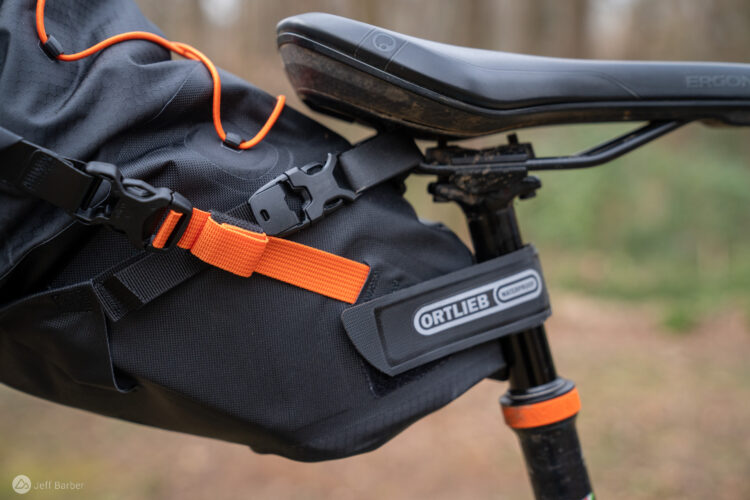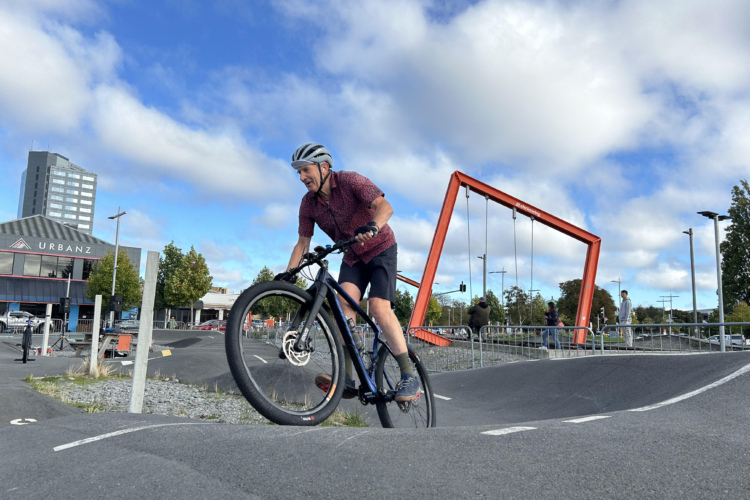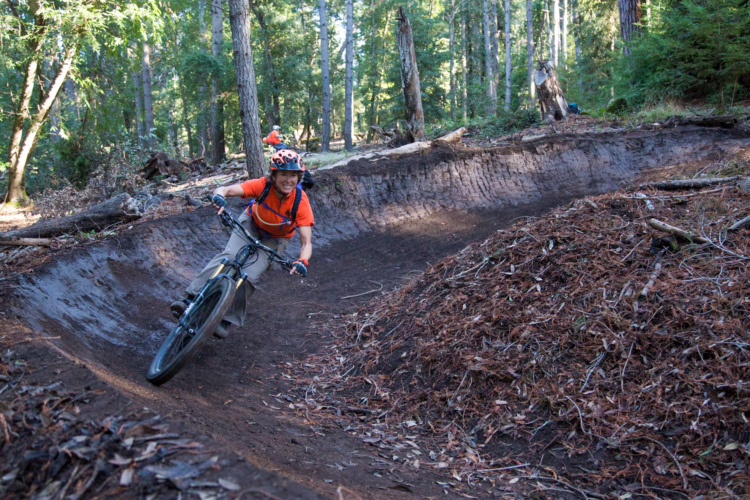
Bikepacking is a lot of fun, and it’s even more fun when you can ride your full suspension mountain bike, especially on singletrack-heavy trips. The Aeroe Spider Rear Rack won’t get hung up by a dropper post or rear wheel compressions like a large seat bag, and promises to fit even more gear too. My friends and I put the rack system through its paces this winter to see if it delivers.
Aeroe Spider Rear Rack key specs
- Base system includes the rack and one cradle (dry bag not included)
- Weight: 990g rack base, hardware, and one cradle
- Price: $149. Dry bags (starting at $59) and additional cradles ($79) sold separately
- Buy from Backcountry.
The Aeroe Spider base rack is designed to fit one, two, or three cradles attached to the sides and/or top of the rack. Each cradle has two straps for attaching a dry bag, rolled up tent, or foam pad. The brand says the rack can hold up to 35lb of cargo.

Installing the Aeroe Spider rack
A rear rack is basically just a bent tube; the real utility is in how it attaches to your bike frame. The Aeroe Spider attaches using an ingenious system of straps anchored to a plastic base that can be rotated to fit a wide variety of bike shapes and sizes. The plastic base has rubber feet to protect the bike frame and likewise the nylon straps feature a rubberized coating that’s no-slip and frame friendly.
I tested the Aeroe Spider Rear Rack on two different full suspension trail bikes — a Canyon Neuron and Marin Rift Zone — plus a couple of hardtails too. The Neuron was an easy fit thanks to its straight seat stays while the Rift Zone, with its curvy stays, only required a slight angle adjustment to the plastic bases.
My friend Craig had hoped to use the Aeroe Spider on a bikepacking trip to Pisgah last month but couldn’t make it work on his 1990s-era 26er hardtail because the rack is too wide. Aeroe doesn’t specify but if your frame isn’t Boost, the Spider might not fit.
Drew needed to wrap some helicopter tape on his hardtail’s skinny seat stays to get a tight fit with the base straps. He then proceeded to ride 200+ miles without needing to make a single adjustment.

Depending on brake hose and derailleur cable routing on your frame you may need to adjust the position of the base. All of the bikes I tested ended up requiring a slightly different rack placement, which took some time to sort out. And I suspect smaller frames may pose additional fit issues. Still, it’s impressive how flexible the system is to account for so many different bike setups.
Another friend warned me to avoid over-torquing the bolts that tighten the nylon straps to the bike frame. In fact Aeroe offers the same warning printed on the base: “Do not over tighten. Max torque 4Nm.” Over torquing could crack the plastic base, a lesson my friend learned the hard way. Admittedly it’s tempting to keep tightening the bolt that pulls the straps onto the frame for added security, but as Drew and I found, the rack is rock solid without needing a lot of torque on the strap bolt.
Share your Aeroe Spider Rear Rack review

Adjust to fit
Once the Aeroe Spider Rear Rack is installed there are still adjustments to be made. For me the whole point of the rack is to get rid of my seat bag so my first check was to make sure I could use the full travel on my dropper post. It’s possible to move the rack up or down an inch or two, and you can also shift it front and back along the seat stays to find the right spot.
When running two cradles left and right on the Spider rack I needed to make adjustments to ensure heel and calf clearance while pedaling. Drew mentioned running into the bags with his heels if he stopped pedaling and stood up on the bike, though he acknowledged that he could have moved the cradles up to avoid this completely.
Aeroe Spider Rear Rack on the trail
To test the security of the Spider Rear Rack I headed straight for the jankiest singletrack I could find. With two full, 8L dry bags I slashed through rock gardens, hucked to flat, and slid down near vertical faces without so much as a rattle. The bags, along with the rack itself, proved secure and stable.
I worried about getting hung up on narrow, tree-lined trails with the bags mounted on the sides of the rack but again, found smooth sailing. The 8L Aeroe branded bags stick out no wider than your legs so unless you’re navigating an especially narrow and tight turn the bags clear trees just fine.



Tire clearance is excellent as well. Aeroe says the Spider fits tires up to 3.8″ wide and there’s a fat-bike version that fits tires up to 5″ wide.
I got full use of my 240mm dropper post on the Canyon Neuron with a dry bag attached to the top and center of the rack. In the past I’ve used a seat bag attached to my dropper post, and while I was able to use most of the travel with it, the return speed is almost glacial due to the added weight of the bag.
There’s no risk of tire buzz, even in compressions, since the bags are essentially fixed to the axle. Handling is much improved over a bikepacking setup that uses a large seat bag because the rack places weight much closer to the ground. And there isn’t there any “wagging” side to side.
A couple friends wondered whether the weighted rack could somehow damage or compromise seat stays since stays likely aren’t designed for this type of loading. It’s hard to say for sure, but in my opinion this shouldn’t be an issue for most bikes, particularly the alloy ones I tested. Running the rack on a steel bike with small diameter seat stay tubes would give me pause, plus doing so also requires wrapping the stays with tape just to make it fit in the first place. IMO it’s probably not worth the effort or the risk. I might attach the rack to a carbon XC bike but definitely would avoid overloading it, which is tempting to do.
With three cradles attached to the Aeroe Spider one could easily replace a seat bag, frame bag, and handlebar bag, packing everything necessary for a few nights in the woods. For me the best configuration is to run two bags, one on each side, in place of a seat bag and handlebar bag. This keeps the front end of the bike light for optimal handling without completely bogging down the rear. Then I use top horizontal bar for mounting a rear blinky light and a flat repair kit. I also recommend adding some reflective tape to the rack to improve visibility on the road.

Pros and cons of Aeroe Spider Rear Rack
Pros
- Adapts to fit a wide range of mountain bikes, including full suspension bikes
- Stable and secure
- Can carry a lot of gear and works with a dropper post
- Clean look and convenient operation
- About the same price as a quality seat bag
Cons
- Requires some trial and error to get the right fit
- Adding accessories quickly increases the overall cost
Bottom line
The Spider Aeroe Rear Rack solves a lot of issues with seat-mounted bags for bikepacking and priced at $149, it’s less expensive than many of them too. With multiple mounting options it’s easy to pack all the gear you need to rip singletrack for days.
- Price: $149. Dry bags (starting at $59) and additional cradles ($79) sold separately
- Buy from Backcountry





















2 Comments
Dec 1, 2024
Dec 3, 2024
Additionally he says, "The Spider Rear Rack has been designed to be flexible. You can easily adjust the legs of the rack by pressing them together or separating them with force up to 20mm on each side, a total of 40mm. To make this adjustment, simply lay the rack on its side and modify/bend accordingly, then attach. This feature effectively minimizes sideways pressure on the seat stays."